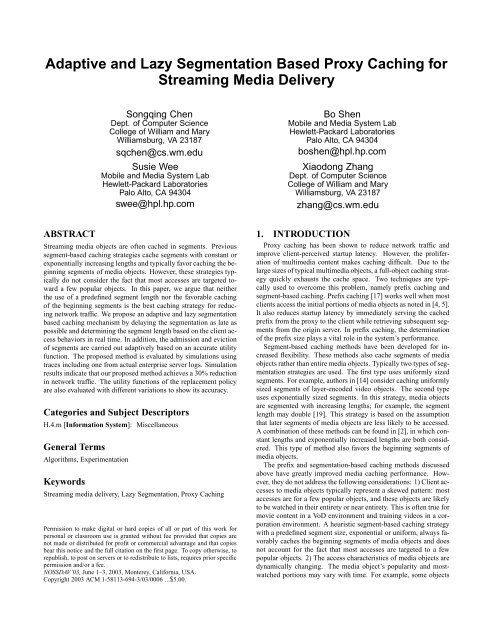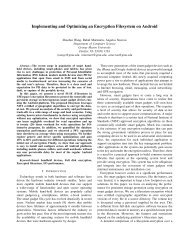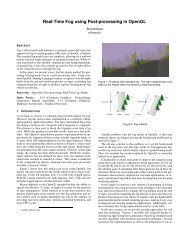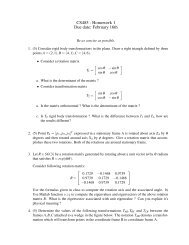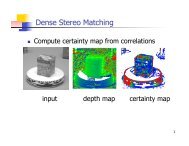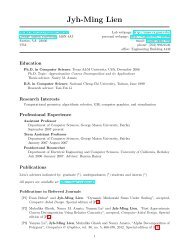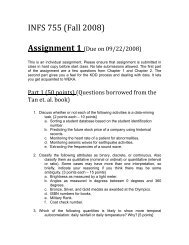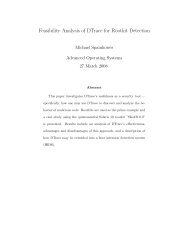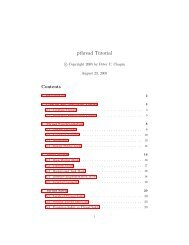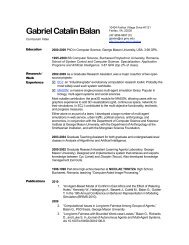Adaptive and Lazy Segmentation Based Proxy Caching ... - CiteSeerX
Adaptive and Lazy Segmentation Based Proxy Caching ... - CiteSeerX
Adaptive and Lazy Segmentation Based Proxy Caching ... - CiteSeerX
You also want an ePaper? Increase the reach of your titles
YUMPU automatically turns print PDFs into web optimized ePapers that Google loves.
<strong>Adaptive</strong> <strong>and</strong> <strong>Lazy</strong> <strong>Segmentation</strong> <strong>Based</strong> <strong>Proxy</strong> <strong>Caching</strong> for<br />
Streaming Media Delivery<br />
Songqing Chen<br />
Dept. of Computer Science<br />
College of William <strong>and</strong> Mary<br />
Williamsburg, VA 23187<br />
sqchen@cs.wm.edu<br />
Susie Wee<br />
Mobile <strong>and</strong> Media System Lab<br />
Hewlett-Packard Laboratories<br />
Palo Alto, CA 94304<br />
swee@hpl.hp.com<br />
Bo Shen<br />
Mobile <strong>and</strong> Media System Lab<br />
Hewlett-Packard Laboratories<br />
Palo Alto, CA 94304<br />
boshen@hpl.hp.com<br />
Xiaodong Zhang<br />
Dept. of Computer Science<br />
College of William <strong>and</strong> Mary<br />
Williamsburg, VA 23187<br />
zhang@cs.wm.edu<br />
ABSTRACT<br />
Streaming media objects are often cached in segments. Previous<br />
segment-based caching strategies cache segments with constant or<br />
exponentially increasing lengths <strong>and</strong> typically favor caching the beginning<br />
segments of media objects. However, these strategies typically<br />
do not consider the fact that most accesses are targeted toward<br />
a few popular objects. In this paper, we argue that neither<br />
the use of a predefined segment length nor the favorable caching<br />
of the beginning segments is the best caching strategy for reducing<br />
network traffic. We propose an adaptive <strong>and</strong> lazy segmentation<br />
based caching mechanism by delaying the segmentation as late as<br />
possible <strong>and</strong> determining the segment length based on the client access<br />
behaviors in real time. In addition, the admission <strong>and</strong> eviction<br />
of segments are carried out adaptively based on an accurate utility<br />
function. The proposed method is evaluated by simulations using<br />
traces including one from actual enterprise server logs. Simulation<br />
results indicate that our proposed method achieves a 30% reduction<br />
in network traffic. The utility functions of the replacement policy<br />
are also evaluated with different variations to show its accuracy.<br />
Categories <strong>and</strong> Subject Descriptors<br />
H.4.m [Information System]: Miscellaneous<br />
General Terms<br />
Algorithms, Experimentation<br />
Keywords<br />
Streaming media delivery, <strong>Lazy</strong> <strong>Segmentation</strong>, <strong>Proxy</strong> <strong>Caching</strong><br />
Permission to make digital or hard copies of all or part of this work for<br />
personal or classroom use is granted without fee provided that copies are<br />
not made or distributed for profit or commercial advantage <strong>and</strong> that copies<br />
bear this notice <strong>and</strong> the full citation on the first page. To copy otherwise, to<br />
republish, to post on servers or to redistribute to lists, requires prior specific<br />
permission <strong>and</strong>/or a fee.<br />
NOSSDAV’03, June 1–3, 2003, Monterey, California, USA.<br />
Copyright 2003 ACM 1-58113-694-3/03/0006 ...$5.00.<br />
1. INTRODUCTION<br />
<strong>Proxy</strong> caching has been shown to reduce network traffic <strong>and</strong><br />
improve client-perceived startup latency. However, the proliferation<br />
of multimedia content makes caching difficult. Due to the<br />
large sizes of typical multimedia objects, a full-object caching strategy<br />
quickly exhausts the cache space. Two techniques are typically<br />
used to overcome this problem, namely prefix caching <strong>and</strong><br />
segment-based caching. Prefix caching [17] works well when most<br />
clients access the initial portions of media objects as noted in [4, 5].<br />
It also reduces startup latency by immediately serving the cached<br />
prefix from the proxy to the client while retrieving subsequent segments<br />
from the origin server. In prefix caching, the determination<br />
of the prefix size plays a vital role in the system’s performance.<br />
Segment-based caching methods have been developed for increased<br />
flexibility. These methods also cache segments of media<br />
objects rather than entire media objects. Typically two types of segmentation<br />
strategies are used. The first type uses uniformly sized<br />
segments. For example, authors in [14] consider caching uniformly<br />
sized segments of layer-encoded video objects. The second type<br />
uses exponentially sized segments. In this strategy, media objects<br />
are segmented with increasing lengths; for example, the segment<br />
length may double [19]. This strategy is based on the assumption<br />
that later segments of media objects are less likely to be accessed.<br />
A combination of these methods can be found in [2], in which constant<br />
lengths <strong>and</strong> exponentially increased lengths are both considered.<br />
This type of method also favors the beginning segments of<br />
media objects.<br />
The prefix <strong>and</strong> segmentation-based caching methods discussed<br />
above have greatly improved media caching performance. However,<br />
they do not address the following considerations: 1) Client accesses<br />
to media objects typically represent a skewed pattern: most<br />
accesses are for a few popular objects, <strong>and</strong> these objects are likely<br />
to be watched in their entirety or near entirety. This is often true for<br />
movie content in a VoD environment <strong>and</strong> training videos in a corporation<br />
environment. A heuristic segment-based caching strategy<br />
with a predefined segment size, exponential or uniform, always favorably<br />
caches the beginning segments of media objects <strong>and</strong> does<br />
not account for the fact that most accesses are targeted to a few<br />
popular objects. 2) The access characteristics of media objects are<br />
dynamically changing. The media object’s popularity <strong>and</strong> mostwatched<br />
portions may vary with time. For example, some objects
may be popular for an initial time period where most users access<br />
entire objects. Then, as the time goes on, there may be fewer requests<br />
for these objects <strong>and</strong> there may be fewer user accesses to the<br />
later portions of the objects. In this scenario, using a fixed strategy<br />
of caching several early segments may not work, since during the<br />
initial time period this may overload the network as later segments<br />
need to be retrieved frequently; then during the later time, caching<br />
all the initial segments may become wasteful of resources. The lack<br />
or poorness of adaptiveness in the existing proxy caching schemes<br />
may render proxy caching to be ineffective. 3) The uniform or the<br />
exponential segmentation methods always use the fixed base segment<br />
size to segment all the objects through the proxy. However,<br />
a proxy is always exposed to objects with a wide range of sizes<br />
from different categories <strong>and</strong> the access characteristics to them can<br />
be quite diverse. Without an adaptive scheme, an overestimate<br />
of the base segment length may cause an inefficient use of cache<br />
space, while an underestimate may cause increased management<br />
overhead.<br />
In this paper, we propose an adaptive <strong>and</strong> lazy segmentation<br />
based caching strategy, which responsively adapts to the real time<br />
accesses <strong>and</strong> lazily segments objects as late as possible. Specifically,<br />
we design an aggressive admission policy, a lazy segmentation<br />
strategy, <strong>and</strong> a two-phase iterative replacement policy. The<br />
proxy system supported by the proposed caching strategy has the<br />
following advantages: 1) It achieves maximal network traffic reduction<br />
by favorably caching the popular segments of media objects,<br />
regardless of their positions within the media object. If most<br />
of the clients tend to watch the initial portions of these objects, the<br />
initial segments are cached. 2) It dynamically adapts to changes in<br />
object access patterns over time. Specifically, it performs well in<br />
common scenarios in which the popularity characteristics of media<br />
objects vary over time. The system automatically takes care of<br />
this situation without assuming a priori access pattern. 3) It adapts<br />
to different types of media objects. Media objects from different<br />
categories are treated fairly with the goal of maximizing caching<br />
efficiency.<br />
Specifically, the adaptiveness of our proposed method falls into<br />
two areas. 1) The segment size of each object is decided adaptively<br />
based on the access history of this object recorded in real time. The<br />
segment size determined in this way more accurately reflects the<br />
client access behaviors. The access history is collected by delaying<br />
the segmentation process. 2) Segment admission <strong>and</strong> eviction<br />
policies are adapted in real time based on the access records. A<br />
utility function is derived to maximize the utilization of the cache<br />
space. Effectively, the cache space is favorably allocated to popular<br />
segments regardless of whether they are initial segments or not.<br />
Both synthetic <strong>and</strong> real proxy traces are used to evaluate the<br />
performance of our proposed method. We show that (1) the uniform<br />
segmentation method achieves a similar performance result<br />
as the exponential segmentation method on average; (2) our proposed<br />
adaptive <strong>and</strong> lazy segmentation strategy outperforms the exponential<br />
<strong>and</strong> the uniform segmentation methods by about 30% in<br />
byte hit ratio on average, which represents a server workload <strong>and</strong><br />
network traffic reduction of 30%.<br />
The rest of the paper is organized as follows. The design of the<br />
adaptive <strong>and</strong> lazy segmentation based caching system is presented<br />
in Section 2. Performance evaluation is presented in Section 3 <strong>and</strong><br />
further evaluation is presented in Section 4. We evaluate the utility<br />
function of the replacement policy in Section 5 <strong>and</strong> make concluding<br />
remarks in Section 6.<br />
1.1 Related Work<br />
<strong>Proxy</strong> caching of streaming media has been explored in [17, 6,<br />
20, 10, 13, 14, 15, 19, 8, 18, 12, 2]. Prefix caching <strong>and</strong> its related<br />
protocol considerations as well as partial sequence caching<br />
are studied in [17, 7, 6]. It had been shown that prefix/suffix caching<br />
is worse than exponential segmentation in terms of caching efficiency<br />
in [19]. Studies have also shown that it is appropriate to<br />
cache popular media objects in their entirety.<br />
Video staging [20] reduces the peak or average b<strong>and</strong>width requirements<br />
between the server <strong>and</strong> proxy channel by considering<br />
the fact that coded video frames have different sizes depending on<br />
the scene complexity <strong>and</strong> coding method. Specifically, if a coded<br />
video frame exceeds a predetermined threshold, then the frame is<br />
cut such that a portion is cached on the proxy while the other portion<br />
remains on the server, thus reducing or smoothing the b<strong>and</strong>width<br />
required between the two. In [13, 14, 15], a similar idea<br />
is proposed for caching scalable video, <strong>and</strong> this is done in a manner<br />
that co-operates with the congestion control mechanism. The<br />
cache replacement mechanism <strong>and</strong> cache resource allocation problems<br />
are studied according to the popularity of video objects.<br />
In [10], the algorithm attempts to partition a video into different<br />
chunks of frames with alternating chunks stored in the proxy, while<br />
in [11], the algorithm may select groups of non-consecutive frames<br />
for caching in the proxy. The caching problem for layer-encoded<br />
video is studied in [8]. The cache replacement of streaming media<br />
is studied in the [18, 12].<br />
2. ADAPTIVE AND LAZY SEGMENTATION<br />
BASED CACHING SYSTEM<br />
This section describes our proposed segmentation-based caching<br />
algorithm. In our algorithm, each object is fully cached according<br />
to the proposed aggressive admission policy when it is accessed for<br />
the first time. The fully cached object is kept in the cache until it<br />
is chosen as an eviction victim by the replacement policy. At that<br />
time, the object is segmented using the lazy segmentation strategy<br />
<strong>and</strong> some segments are evicted by the first phase of the two-phase<br />
iterative replacement policy. From then on, the segments of the<br />
object are adaptively admitted by the aggressive admission policy<br />
or adaptively replaced as described in the second phase of the twophase<br />
iterative replacement policy.<br />
For any media object accessed through the proxy, a data structure<br />
containing the following items is created <strong>and</strong> maintained. This data<br />
structure is called the access log of the object.<br />
• T 1: the time instance the object is accessed for the first time;<br />
• T r: the last reference time of the object. It is equal to T 1<br />
when the object is accessed for the first time;<br />
• L sum: the sum of the duration of each access to the object;<br />
• n: the number of accesses to the object;<br />
• L b : the length of the base segment;<br />
• n s: the number of the cached segments of the object.<br />
Quantities T r, n <strong>and</strong> n s are dynamically updated upon each access<br />
arrival. Quantity L sum is updated upon each session termination.<br />
Quantity L b is decided when the object is segmented.<br />
In addition, the following quantities can be derived from the<br />
above items <strong>and</strong> are used as measurements of access activities to<br />
each object. In our design, T c is used to denote the current time<br />
instance. At time instance T c, we denote the access frequency F as<br />
n<br />
T r−T 1<br />
, <strong>and</strong> denote the average access duration L avg as Lsum . Both<br />
n<br />
of these quantities are also updated upon each access arrival.
We now present the three major modules of the caching system.<br />
The aggressive admission policy is presented in section 2.1. Section<br />
2.2 describes the lazy segmentation strategy. Details of the<br />
two-phase iterative replacement policy are presented in section 2.3.<br />
2.1 Aggressive Admission Policy<br />
For any media object, cache admission is evaluated each time it<br />
is accessed with the following aggressive admission policy.<br />
• If there is no access log for the object, the object is accessed<br />
for the first time. Assuming the full length of the object<br />
is known to the proxy, sufficient cache space is allocated<br />
through an adaptive replacement algorithm as described in<br />
section 2.3. The accessed object is subsequently cached entirely<br />
regardless of the request’s accessing duration. An access<br />
log is also created for the object <strong>and</strong> the recording of the<br />
access history begins.<br />
• If an access log exists for the object (not the first time), but<br />
the log indicates that the object is fully cached, the access log<br />
is updated. No cache admission is necessary.<br />
• If an access log exists for the object (not the first time), but<br />
the log indicates that the object is not fully cached, the system<br />
aggressively considers caching the (n s + 1)th segment<br />
if L avg ≥ 1 a ∗(ns +1)∗L b, where a is a constant determined<br />
by the replacement policy (see section 2.3). The inequality<br />
indicates that the average access duration is increasing to the<br />
extent that the cached n s segments can not cover most of the<br />
requests while a total of n s + 1 segments can. Therefore, the<br />
system should consider the admission of the next uncached<br />
segment. The final determination of whether this uncached<br />
segment is finally cached or not is determined by the replacement<br />
policy (see section 2.3). (In our system, a = 2, that is,<br />
when Lsum ≥ ns+1 ∗ L<br />
n 2 b is true, the next uncached segment<br />
of this object is considered to be cached.)<br />
In summary, using aggressive admission, the object is fully admitted<br />
when it is accessed for the first time. Then the admission of<br />
this object is considered segment by segment.<br />
2.2 <strong>Lazy</strong> <strong>Segmentation</strong> Strategy<br />
The key of the lazy segmentation strategy is as follows. Once<br />
there is no cache space available <strong>and</strong> thus cache replacement is<br />
needed, the replacement policy calculates the caching utility of<br />
each cached object (see section 2.3). Subsequently, the object with<br />
the smallest utility value is chosen as the victim if it is not active<br />
(no request is currently accessing it). If the victim object is fully<br />
cached, the proxy segments the object as follows. The average access<br />
duration L avg at current time instance is calculated. It is used<br />
as the length of the base segment of this object, that is, L b = L avg.<br />
Note that the value of L b is fixed once it is determined. The object<br />
is then segmented uniformly based on L b . After that, the first a<br />
segments are kept in the cache, while the remaining segments are<br />
evicted (see section 2.3). The number of cached segments, n s, is<br />
updated in the access log of the object accordingly. If a later request<br />
dem<strong>and</strong>s more than the cached number of segments of this<br />
object, data of length L b (except for the last segment) is prefetched<br />
from the server.<br />
In contrast with existing segmentation strategies, in which segmentation<br />
is performed when the object is accessed for the first<br />
time, the lazy segmentation strategy delays the segmentation process<br />
as late as possible, thus allowing the proxy to collect a sufficient<br />
amount of accessing statistics to improve the accuracy of the<br />
segmentation for each media object. By using the lazy segmentation<br />
strategy, the system adaptively sets different base segment<br />
lengths for different objects according to real time user access behaviors.<br />
2.3 Two-Phase Iterative Replacement Policy<br />
The replacement policy is used to select cache eviction victims.<br />
We design a two-phase iterative replacement policy as follows. First<br />
of all, a utility function is derived to help the victim selection process.<br />
Several factors are considered to predict future accesses.<br />
• The average number of accesses;<br />
• the average duration of accesses;<br />
• the length of the cached data (could be the whole object, or<br />
could be some segments), which is the cost of the storage;<br />
<strong>and</strong><br />
• the probability of the future access. In addition to the above<br />
factors used to predict the users’ future access behaviors, the<br />
two-phase iterative replacement policy considers the possibility<br />
of future accesses as follows: the system compares the<br />
T c − T r, the time interval between now <strong>and</strong> the most recent<br />
access, <strong>and</strong> the Tr−T 1<br />
, the average time interval for an<br />
n<br />
access happening in the past. If T c −T r > Tr−T 1<br />
, the possibility<br />
that a new request arrives soon for this object is small.<br />
n<br />
Otherwise, it is more likely that a request may be coming<br />
soon.<br />
Intuitively, the caching utility of an object is proportional to the<br />
average number of accesses, the average duration of accesses <strong>and</strong><br />
the probability of accesses. In addition, it is inversely proportional<br />
to the size of the occupied cache space. Therefore, the caching<br />
utility function of each object is defined as follows:<br />
f 1( Lsum<br />
n )p 1<br />
∗ f 2(F ) p 2<br />
∗ MIN{1, Tr−T 1<br />
n<br />
f 3(n s ∗ L b ) p 3<br />
T c−T r<br />
}<br />
where<br />
f 1( Lsum ) represents the average duration of future access;<br />
n<br />
f 2(F ) represents the average number of future accesses;<br />
, (1)<br />
MIN{1, Tr−T 1<br />
n<br />
T c−T r<br />
} denotes the possibility of future accesses; <strong>and</strong><br />
f 3(n s ∗ L b ) is the cost of disk storage.<br />
Equation 1 can be simplified as<br />
L sum<br />
T r−T 1<br />
∗ MIN{1, Tr−T 1<br />
n<br />
T c−T r<br />
}<br />
n s ∗ L b<br />
(2)<br />
when p 1 = 1, p 2 = 1 <strong>and</strong> p 3 = 1.<br />
Compared with the distance-sensitive utility function<br />
1<br />
T c−T r<br />
1<br />
(T c−T r)×i<br />
(i represents the i th segment, is the estimated frequency)<br />
used in the exponential segmentation method [19] which favorably<br />
caches segments closer to the beginning of media objects, the proposed<br />
utility function provides a more accurate estimation based on<br />
the popularity of segments regardless of their relative positions in<br />
the media object. This helps to ensure that less popular segments<br />
get evicted from the cache.<br />
Given the definition of the utility function, we design a twophase<br />
iterative replacement policy to maximize the aggregated utility<br />
value of the cached objects. Upon object admission, if there is<br />
not enough cache space, the system calculates the caching utility<br />
of each object currently in the cache. The object with the smallest<br />
utility value is chosen as the victim <strong>and</strong> partial cached data of this<br />
object is evicted in one of the two phases as follows.
• First Phase: If the access log of the object indicates that the<br />
object is fully cached, the object is segmented as described<br />
in section 2.2. The first a (a = 2) segments are kept <strong>and</strong><br />
the rest segments are evicted right after the segmentation is<br />
completed. Therefore, the portion of the object left in cache<br />
is of length 2 ∗ L b . Given that L b = L avg at this time instance,<br />
the cached 2 segments cover a normal distribution in<br />
the access duration.<br />
• Second Phase: If the access log of the object indicates that<br />
the object is partially cached, the last cached segment of this<br />
object is evicted.<br />
The utility value of the object is updated after each replacement<br />
<strong>and</strong> this process repeats iteratively until the required space is found.<br />
The design of the two-phase iterative replacement policy reduces<br />
the chances of making wrong decisions of the replacement, <strong>and</strong><br />
gives fair chances to the replaced segments so that they can be<br />
cached back into the proxy again by the aggressive admission policy<br />
if they become popular again. In addition, the iterative nature of<br />
the replacement procedure ensures that the aggregated utility value<br />
of the cached objects is maximized.<br />
Note that even after an object is fully replaced, the system still<br />
keeps its access log. If not, when the object is accessed again, it<br />
should be fully cached again. Since media objects tend to have<br />
diminishing popularity as the time goes on, if the system caches<br />
the object in full again, it results in an inefficient use of the cache<br />
space. Our design enhances the resource utilization by avoiding<br />
this kind of situation.<br />
3. PERFORMANCE EVALUATION<br />
An event-driven simulator is implemented to evaluate the performance<br />
of the exponential segmentation, the uniform segmentation,<br />
<strong>and</strong> our proposed adaptive <strong>and</strong> lazy segmentation techniques by<br />
using synthetic <strong>and</strong> real traces. For the adaptive <strong>and</strong> lazy segmentation<br />
strategy, Equation 2 is used as the utility function. The exponential<br />
segmentation strategy always reserves a portion of cache<br />
space (10%) for beginning segments, <strong>and</strong> leaves the rest for later<br />
segments. The utility function used is as described in section 2.3 for<br />
the replacement of later segments, while the LRU policy is used for<br />
the beginning segments. The only difference between the uniform<br />
segmentation <strong>and</strong> the exponential segmentation method is as follows.<br />
Instead of segmenting the object exponentially, the uniform<br />
segmentation strategy segments the object with a constant length.<br />
Since the exponential segmentation strategy always caches the first<br />
6 segments as in [19], for a fair comparison, the uniform segmentation<br />
strategy always caches the same length of first several segments<br />
of media objects. Thus whether the exponentially increasing<br />
segment length plays an important role can also be evaluated.<br />
The byte hit ratio is defined as how many bytes are delivered to<br />
the client from the proxy directly, normalized by the total bytes the<br />
client requested. It is used as the major metric to evaluate the reduction<br />
of the network traffic to the server <strong>and</strong> the disk b<strong>and</strong>width<br />
utilization on the server. The delayed start request ratio is defined<br />
as how many requests among the total do not have a startup latency<br />
since the initial portion of the requested object is cached on the<br />
proxy. It is used to indicate the efficiency of these techniques in<br />
reducing the user perceived startup latency. The average number<br />
of cached objects per time unit denotes that the average number of<br />
objects whose segments are partially or fully cached. It is used to<br />
indicate whether the method favorably caches the beginning segments<br />
of a large number of different objects or favorably caches<br />
the popular segments of a small number of different objects.<br />
3.1 Workload Summary<br />
Table 1 lists some known properties of synthetic traces <strong>and</strong> an<br />
actual enterprise trace.<br />
Trace Num of Num of Size λ α Range Duration<br />
Name Request Object (GB) (minute) (day)<br />
WEB 15188 400 51 4 0.47 2-120 1<br />
VOD 10731 100 149 60 0.73 60-120 7<br />
PART 15188 400 51 4 0.47 2-120 1<br />
REAL 9000 403 20 - - 6 - 131 10<br />
Table 1: Workload Summary<br />
WEB <strong>and</strong> VOD denote the traces for the Web <strong>and</strong> VoD environment<br />
with complete viewing, while PARTIAL denotes the trace<br />
for the Web environment with partial viewing. These synthetic<br />
N<br />
traces assume a Zipf-like distribution (p i = f i/<br />
i=1<br />
fi, fi =<br />
1/i α ) for the popularity of media objects. They also assume the<br />
request arrival follows the Poisson distribution (p(x, λ) = e −λ ∗<br />
(λ) x /(x!), x = 0, 1, 2...).<br />
REAL denotes the trace extracted from server logs of HP Corporate<br />
Media Solutions, covering the period from April 1 through<br />
April 10, 2001.<br />
3.2 Evaluation on Complete Viewing Traces<br />
Figure 1 shows the performance results from simulations using<br />
the WEB trace. <strong>Lazy</strong> segmentation refers to our proposed adaptive<br />
<strong>and</strong> lazy segmentation method. Exponential segmentation refers to<br />
the exponential segmentation method. Uniform segmentation (1K)<br />
refers to the uniform segmentation method with 1KB sized segments,<br />
while uniform segmentation (1M) refers to the uniform segmentation<br />
method with 1MB sized segments 1 . Evident from Figure<br />
1(a), lazy segmentation achieves the highest byte hit ratio. When<br />
the cache size is 10%, 20% <strong>and</strong> 30% of the total object size, the<br />
byte hit ratios of lazy segmentation <strong>and</strong> exponential segmentation<br />
are more than 50% <strong>and</strong> 13%, 67% <strong>and</strong> 39%, 75% <strong>and</strong> 29%, respectively.<br />
The absolute performance gap is more than 30% on average<br />
<strong>and</strong> gradually decreases with the increase of available cache space.<br />
On average, uniform segmentation achieves a similar result as exponential<br />
segmentation, which indicates that the exponentially increased<br />
length does not have an obvious effect on the byte hit ratio.<br />
Figure 1(b) shows that in terms of the delayed start request ratio,<br />
uniform segmentation (1K) achieves the best result, while exponential<br />
segmentation is ranked second. This is expected since both<br />
of them always favorably cache the beginning segments of media<br />
objects. <strong>Lazy</strong> segmentation achieves the worst percentage among<br />
the three. The results indicate that the achieved high byte hit ratio<br />
is paid at the expense of a high delayed start request ratio.<br />
Figure 1(c) shows the average number of cached objects per time<br />
unit. <strong>Lazy</strong> segmentation always has the least number of objects<br />
cached on average, while it always achieves the best byte hit ratio.<br />
The results implicitly indicate that favorably caching the beginning<br />
segments of media objects is not efficient in reducing network traffic<br />
to the server <strong>and</strong> disk b<strong>and</strong>width utilization on the server.<br />
The results of the VOD trace shown in Figure 2 show similar<br />
trends as those of WEB. The byte hit ratio of lazy segmentation<br />
is improved by 28, 24 <strong>and</strong> 10 percentage points over exponential<br />
segmentation when the cache size is 10%, 20% <strong>and</strong> 30% of the<br />
total object size correspondingly.<br />
Since WEB <strong>and</strong> VOD are the complete viewing scenarios, results<br />
from simulations using these two traces demonstrate that in<br />
1 In the following context, we also use them to represent their corresponding<br />
strategies for brevity.
Byte Hit Ratio (%)<br />
100<br />
80<br />
60<br />
40<br />
<strong>Lazy</strong> <strong>Segmentation</strong><br />
20<br />
Exponential <strong>Segmentation</strong><br />
Uniform <strong>Segmentation</strong>(1K)<br />
Uniform <strong>Segmentation</strong> (1M)<br />
0<br />
0 20 40 60 80 100<br />
Cache Size (Percentage of the Total Object Size)<br />
Delayed Start Request Ratio (%)<br />
100<br />
80<br />
60<br />
40<br />
20<br />
<strong>Lazy</strong> <strong>Segmentation</strong><br />
Exponential <strong>Segmentation</strong><br />
Uniform <strong>Segmentation</strong>(1K)<br />
Uniform <strong>Segmentation</strong> (1M)<br />
0<br />
0 20 40 60 80 100<br />
Cache Size (Percentage of the Total Object Size)<br />
Average Number of Cached Objects<br />
400<br />
350<br />
300<br />
250<br />
200<br />
150<br />
100<br />
<strong>Lazy</strong> <strong>Segmentation</strong><br />
Exponential <strong>Segmentation</strong><br />
50<br />
Uniform <strong>Segmentation</strong>(1K)<br />
Uniform <strong>Segmentation</strong> (1M)<br />
0<br />
0 20 40 60 80 100<br />
Cache Size (Percentage of the Total Object Size)<br />
Figure 1: WEB: (a) Byte Hit Ratio, (b) Delayed Start Request ratio, <strong>and</strong> (c) Average Number of Cached Objects<br />
Byte Hit Ratio (%)<br />
100<br />
80<br />
60<br />
40<br />
<strong>Lazy</strong> <strong>Segmentation</strong><br />
20<br />
Exponential <strong>Segmentation</strong><br />
Uniform <strong>Segmentation</strong>(1K)<br />
Uniform <strong>Segmentation</strong> (1M)<br />
0<br />
0 20 40 60 80 100<br />
Cache Size (Percentage of the Total Object Size)<br />
Delayed Start Request Ratio (%)<br />
100<br />
80<br />
60<br />
40<br />
20<br />
<strong>Lazy</strong> <strong>Segmentation</strong><br />
Exponential <strong>Segmentation</strong><br />
Uniform <strong>Segmentation</strong>(1K)<br />
Uniform <strong>Segmentation</strong> (1M)<br />
0<br />
0 20 40 60 80 100<br />
Cache Size (Percentage of the Total Object Size)<br />
Average Number of Cached Objects<br />
100<br />
80<br />
60<br />
40<br />
<strong>Lazy</strong> <strong>Segmentation</strong><br />
20<br />
Exponential <strong>Segmentation</strong><br />
Uniform <strong>Segmentation</strong>(1K)<br />
Uniform <strong>Segmentation</strong> (1M)<br />
0<br />
0 20 40 60 80 100<br />
Cache Size (Percentage of the Total Object Size)<br />
Figure 2: VOD: (a) Byte Hit Ratio, (b) Delayed Start Request Ratio, <strong>and</strong> (c) Average Number of Cached Objects<br />
terms of the byte hit ratio, it is more appropriate to cache the popular<br />
segments of objects instead of favorably caching the beginning<br />
segments of a media object. It also implicitly shows that the<br />
two-phase iterative replacement policy of our proposed method can<br />
successfully identify the popular objects when compared with the<br />
distance-sensitive replacement policy used in the the exponential<br />
segmentation technique.<br />
3.3 Evaluation on Partial Viewing Traces<br />
Figure 3 shows the performance results from simulations using<br />
PARTIAL. 80% of requests in PARTIAL only access 20% of the<br />
object. Shown in Figure 3(a), lazy segmentation achieves the best<br />
byte hit ratio: when the cache size is 10%, 20% <strong>and</strong> 30% of the total<br />
object size, the byte hit ratio increases by 28, 42, <strong>and</strong> 7 percentage<br />
points, respectively, over the exponential segmentation method.<br />
Compared with results of WEB, the improvement of our proposed<br />
method over the exponential segmentation method is reduced due<br />
to the 80% partial viewing sessions. Again, uniform segmentation<br />
(1K) achieves a similar byte hit ratio as that of exponential segmentation<br />
on average.<br />
Figure 3(b) shows the delayed start request ratio. As expected,<br />
the lowest is achieved by uniform segmentation (1K) while exponential<br />
segmentation still gets the second lowest percentage. <strong>Lazy</strong><br />
segmentation achieves the highest. This confirms that the higher<br />
byte hit ratio is paid by a higher delayed start request ratio.<br />
Figure 3(c) shows the average number of cached objects of PAR-<br />
TIAL. It shows that lazy segmentation always has the least number<br />
of objects cached, while it always achieves the highest byte hit ratio.<br />
The results further indicate that favorably caching the beginning<br />
segments of media objects is not effective for alleviating the<br />
bottlenecks of delivering streaming media objects.<br />
For the real trace REAL, Figure 4(a) shows the byte hit ratio as a<br />
function of increased cache size. When the cache size is 20%, 30%,<br />
40% <strong>and</strong> 50% of the total object size, the byte hit ratio increases<br />
of lazy segmentation are 31, 28, 29, 30 percentage points, respectively,<br />
over exponential segmentation. The average performance<br />
improvement is about 30 percentage points. The trends shown in<br />
Figure 4(a) are consistent with the previous ones.<br />
Figure 4(b) shows the delayed start request ratio for the REAL<br />
trace. It shows that lazy segmentation has similar results as exponential<br />
segmentation. Its performance even exceeds that of exponential<br />
segmentation when the cache size is 10% <strong>and</strong> 20% of the<br />
total cache size. This is due to the nature of partial viewing in<br />
REAL. In our proposed method, much cache space is available for<br />
the beginning segments of objects. The result reflects the adaptiveness<br />
of our proposed method.<br />
Figure 4(c) shows that consistent with previous evaluations, our<br />
proposed method still has the least number of objects cached on<br />
average while achieving the highest byte hit ratio.<br />
The results of REAL show that lazy segmentation achieves the<br />
highest byte hit ratio <strong>and</strong> nearly the lowest delayed start request<br />
ratio. The adaptiveness of our proposed method shown in this evaluation<br />
confirms our analysis in Section 1.<br />
All these performance results show that: (1) in terms of byte hit<br />
ratio (reductions of server workload <strong>and</strong> network traffic), our proposed<br />
adaptive <strong>and</strong> lazy segmentation method always performs best<br />
with the least number of objects cached; (2) uniform segmentation<br />
(1K) achieves a similar result on both the byte hit ratio <strong>and</strong> the delayed<br />
start request ratio as the exponential segmentation method on<br />
average.<br />
The performance results also indicate that favorably caching the<br />
beginning segments of media objects is not effective in alleviating
Byte Hit Ratio (%)<br />
100<br />
80<br />
60<br />
40<br />
<strong>Lazy</strong> <strong>Segmentation</strong><br />
20<br />
Exponential <strong>Segmentation</strong><br />
Uniform <strong>Segmentation</strong>(1K)<br />
Uniform <strong>Segmentation</strong> (1M)<br />
0<br />
0 20 40 60 80 100<br />
Cache Size (Percentage of the Total Object Size)<br />
Delayed Start Request Ratio (%)<br />
100<br />
80<br />
60<br />
40<br />
20<br />
<strong>Lazy</strong> <strong>Segmentation</strong><br />
Exponential <strong>Segmentation</strong><br />
Uniform <strong>Segmentation</strong>(1K)<br />
Uniform <strong>Segmentation</strong> (1M)<br />
0<br />
0 20 40 60 80 100<br />
Cache Size (Percentage of the Total Object Size)<br />
Average Number of Cached Objects<br />
400<br />
350<br />
300<br />
250<br />
200<br />
150<br />
100<br />
<strong>Lazy</strong> <strong>Segmentation</strong><br />
Exponential <strong>Segmentation</strong><br />
50<br />
Uniform <strong>Segmentation</strong>(1K)<br />
Uniform <strong>Segmentation</strong> (1M)<br />
0<br />
0 20 40 60 80 100<br />
Cache Size (Percentage of the Total Object Size)<br />
Figure 3: PART: (a) Byte Hit Ratio, (b) Delayed Start Request Ratio, <strong>and</strong> (c) Average Number of Cached Objects<br />
Byte Hit Ratio (%)<br />
100<br />
80<br />
60<br />
40<br />
<strong>Lazy</strong> <strong>Segmentation</strong><br />
20<br />
Exponential <strong>Segmentation</strong><br />
Uniform <strong>Segmentation</strong>(1K)<br />
Uniform <strong>Segmentation</strong> (1M)<br />
0<br />
0 20 40 60 80 100<br />
Cache Size (Percentage of the Total Object Size)<br />
Delayed Start Request Ratio (%)<br />
100<br />
80<br />
60<br />
40<br />
20<br />
<strong>Lazy</strong> <strong>Segmentation</strong><br />
Exponential <strong>Segmentation</strong><br />
Uniform <strong>Segmentation</strong>(1K)<br />
Uniform <strong>Segmentation</strong> (1M)<br />
0<br />
0 20 40 60 80 100<br />
Cache Size (Percentage of the Total Object Size)<br />
Average Number of Cached Objects<br />
300<br />
250<br />
200<br />
150<br />
100<br />
<strong>Lazy</strong> <strong>Segmentation</strong><br />
50<br />
Exponential <strong>Segmentation</strong><br />
Uniform <strong>Segmentation</strong>(1K)<br />
Uniform <strong>Segmentation</strong> (1M)<br />
0<br />
0 20 40 60 80 100<br />
Cache Size (Percentage of the Total Object Size)<br />
Figure 4: REAL: (a) Byte Hit Ratio, (b) Delayed Start Request Ratio, <strong>and</strong> (c) Average Number of Cached Objects<br />
the bottlenecks for delivering streaming media <strong>and</strong> exponentially<br />
increasing segment length does not have an obvious advantage over<br />
constant segment length in terms of byte hit ratio.<br />
Uniform segmentation with other base segment lengths are also<br />
tested. They achieve similar performance results as those of uniform<br />
segmentation (1M) in byte hit ratio <strong>and</strong> worse results in delayed<br />
start request ratio.<br />
4. ADDITIONAL RESULTS<br />
In Section 3, the adaptive <strong>and</strong> lazy segmentation strategy is evaluated<br />
comparatively with the exponential segmentation <strong>and</strong> the uniform<br />
segmentation strategies. We have learned that generally the<br />
adaptive <strong>and</strong> lazy segmentation strategy achieves a higher byte hit<br />
ratio. We also know that the adaptive <strong>and</strong> lazy segmentation strategy<br />
does not reserve space for beginning segments of media objects,<br />
while the exponential segmentation <strong>and</strong> uniform segmentation<br />
strategies do reserve space for beginning segments (10% of<br />
the total cache size in the experiments). Thus one may argue that<br />
the higher byte hit ratio achieved by lazy segmentation comes from<br />
freeing the reserved space. To examine whether this is true or not,<br />
two groups of experiments are designed <strong>and</strong> performed based on<br />
the changes of either the lazy segmentation strategy, either the exponential<br />
<strong>and</strong> uniform segmentation strategies. These experiments<br />
are used to evaluate whether the freeing of reserved space has a significant<br />
impact on the byte hit ratio improvement achieved by lazy<br />
segmentation.<br />
4.1 Small Cache Size for <strong>Lazy</strong> <strong>Segmentation</strong><br />
Firstly, we use a smaller cache space for lazy segmentation. It<br />
means that the available cache space for the adaptive <strong>and</strong> lazy segmentation<br />
strategy is the same as the cache space for the exponential<br />
segmentation strategy other than the reserved part. In these<br />
experiments, the reserved portion for the exponential segmentation<br />
strategy is set to 10%, thus the totally available cache space for<br />
lazy segmentation is only 90% of the cache space for exponential<br />
segmentation. The remaining 10% is reserved for no use.<br />
Figure 5 shows the corresponding results using the WEB trace.<br />
Compared with Figure 1, the achieved byte hit ratio of lazy segmentation<br />
does decrease a little. However, it still achieves the highest<br />
byte hit ratio among all the strategies as shown in Figure 5(a). In<br />
Figure 5(b), the delayed start request ratio achieved by lazy segmentation<br />
is even worse compared to Figure 1(b), due to the decrease<br />
of the total available cache size. Figure 5(c) shows that due<br />
to the case when only 90% space is available for lazy segmentation,<br />
the average number of cached objects is less than the total number<br />
of objects when the cache size is 100% of the total object size.<br />
The results using the VOD trace is shown in Figure 6. All the<br />
trends indicated on Figure 6 are similar to those on Figure 5, with<br />
smaller changes correspondingly. The smaller changes are due to<br />
the longer durations of the VOD trace.<br />
Compared with Figure 3, the variations of results using the trace<br />
PARTIAL in Figure 7 are more significant on byte hit ratio <strong>and</strong> delayed<br />
start request ratio. Due to the partial viewing nature of this<br />
trace, the performance results are more sensitive to the changes<br />
of the available cache size for the adaptive <strong>and</strong> lazy segmentation<br />
strategy. However, lazy segmentation still has a significant advantage<br />
over the others in achieving a high byte hit ratio. Note that<br />
in Figure 7, the average number of cached objects reaches the total<br />
number of objects when the cache size is 100%. This is different in<br />
Figure 5 <strong>and</strong> Figure 6.<br />
Figure 8 shows the corresponding results using the REAL trace.<br />
The byte hit ratio, delayed start request ratio, <strong>and</strong> average number
Byte Hit Ratio (%)<br />
100<br />
80<br />
60<br />
40<br />
<strong>Lazy</strong> <strong>Segmentation</strong><br />
20<br />
Exponential <strong>Segmentation</strong><br />
Uniform <strong>Segmentation</strong>(1K)<br />
Uniform <strong>Segmentation</strong> (1M)<br />
0<br />
0 20 40 60 80 100<br />
Cache Size (Percentage of the Total Object Size)<br />
Delayed Start Request Ratio (%)<br />
100<br />
80<br />
60<br />
40<br />
20<br />
<strong>Lazy</strong> <strong>Segmentation</strong><br />
Exponential <strong>Segmentation</strong><br />
Uniform <strong>Segmentation</strong>(1K)<br />
Uniform <strong>Segmentation</strong> (1M)<br />
0<br />
0 20 40 60 80 100<br />
Cache Size (Percentage of the Total Object Size)<br />
Average Number of Cached Objects<br />
400<br />
350<br />
300<br />
250<br />
200<br />
150<br />
100<br />
<strong>Lazy</strong> <strong>Segmentation</strong><br />
Exponential <strong>Segmentation</strong><br />
50<br />
Uniform <strong>Segmentation</strong>(1K)<br />
Uniform <strong>Segmentation</strong> (1M)<br />
0<br />
0 20 40 60 80 100<br />
Cache Size (Percentage of the Total Object Size)<br />
Figure 5: WEB: (a) Byte Hit Ratio, (b) Delayed Start Request Ratio, <strong>and</strong> (c) Average Number of Cached Objects<br />
Byte Hit Ratio (%)<br />
100<br />
80<br />
60<br />
40<br />
<strong>Lazy</strong> <strong>Segmentation</strong><br />
20<br />
Exponential <strong>Segmentation</strong><br />
Uniform <strong>Segmentation</strong>(1K)<br />
Uniform <strong>Segmentation</strong> (1M)<br />
0<br />
0 20 40 60 80 100<br />
Cache Size (Percentage of the Total Object Size)<br />
Delayed Start Request Ratio (%)<br />
100<br />
80<br />
60<br />
40<br />
20<br />
<strong>Lazy</strong> <strong>Segmentation</strong><br />
Exponential <strong>Segmentation</strong><br />
Uniform <strong>Segmentation</strong>(1K)<br />
Uniform <strong>Segmentation</strong> (1M)<br />
0<br />
0 20 40 60 80 100<br />
Cache Size (Percentage of the Total Object Size)<br />
Average Number of Cached Objects<br />
100<br />
80<br />
60<br />
40<br />
20<br />
<strong>Lazy</strong> <strong>Segmentation</strong><br />
Exponential <strong>Segmentation</strong><br />
Uniform <strong>Segmentation</strong>(1K)<br />
Uniform <strong>Segmentation</strong> (1M)<br />
0<br />
0 20 40 60 80 100<br />
Cache Size (Percentage of the Total Object Size)<br />
Figure 6: VOD: (a) Byte Hit Ratio, (b) Delayed Start Request Ratio, <strong>and</strong> (c) Average Number of Cached Objects<br />
Byte Hit Ratio (%)<br />
100<br />
80<br />
60<br />
40<br />
<strong>Lazy</strong> <strong>Segmentation</strong><br />
20<br />
Exponential <strong>Segmentation</strong><br />
Uniform <strong>Segmentation</strong>(1K)<br />
Uniform <strong>Segmentation</strong> (1M)<br />
0<br />
0 20 40 60 80 100<br />
Cache Size (Percentage of the Total Object Size)<br />
Delayed Start Request Ratio (%)<br />
100<br />
80<br />
60<br />
40<br />
20<br />
<strong>Lazy</strong> <strong>Segmentation</strong><br />
Exponential <strong>Segmentation</strong><br />
Uniform <strong>Segmentation</strong>(1K)<br />
Uniform <strong>Segmentation</strong> (1M)<br />
0<br />
0 20 40 60 80 100<br />
Cache Size (Percentage of the Total Object Size)<br />
Average Number of Cached Objects<br />
400<br />
350<br />
300<br />
250<br />
200<br />
150<br />
100<br />
<strong>Lazy</strong> <strong>Segmentation</strong><br />
Exponential <strong>Segmentation</strong><br />
50<br />
Uniform <strong>Segmentation</strong>(1K)<br />
Uniform <strong>Segmentation</strong> (1M)<br />
0<br />
0 20 40 60 80 100<br />
Cache Size (Percentage of the Total Object Size)<br />
Figure 7: PART: (a) Byte Hit Ratio, (b) Delayed Start Request Ratio, <strong>and</strong> (c) Average Number of Cached Objects<br />
Byte Hit Ratio (%)<br />
100<br />
80<br />
60<br />
40<br />
<strong>Lazy</strong> <strong>Segmentation</strong><br />
20<br />
Exponential <strong>Segmentation</strong><br />
Uniform <strong>Segmentation</strong>(1K)<br />
Uniform <strong>Segmentation</strong> (1M)<br />
0<br />
0 20 40 60 80 100<br />
Cache Size (Percentage of the Total Object Size)<br />
Delayed Start Request Ratio (%)<br />
100<br />
80<br />
60<br />
40<br />
20<br />
<strong>Lazy</strong> <strong>Segmentation</strong><br />
Exponential <strong>Segmentation</strong><br />
Uniform <strong>Segmentation</strong>(1K)<br />
Uniform <strong>Segmentation</strong> (1M)<br />
0<br />
0 20 40 60 80 100<br />
Cache Size (Percentage of the Total Object Size)<br />
Average Number of Cached Objects<br />
300<br />
250<br />
200<br />
150<br />
100<br />
<strong>Lazy</strong> <strong>Segmentation</strong><br />
50<br />
Exponential <strong>Segmentation</strong><br />
Uniform <strong>Segmentation</strong>(1K)<br />
Uniform <strong>Segmentation</strong> (1M)<br />
0<br />
0 20 40 60 80 100<br />
Cache Size (Percentage of the Total Object Size)<br />
Figure 8: REAL: (a) Byte Hit Ratio, (b) Delayed Start Request Ratio, <strong>and</strong> (c) Average Number of Cached Objects
Byte Hit Ratio (%)<br />
100<br />
80<br />
60<br />
40<br />
<strong>Lazy</strong> <strong>Segmentation</strong><br />
20<br />
Exponential <strong>Segmentation</strong><br />
Uniform <strong>Segmentation</strong>(1K)<br />
Uniform <strong>Segmentation</strong> (1M)<br />
0<br />
0 20 40 60 80 100<br />
Cache Size (Percentage of the Total Object Size)<br />
Delayed Start Request Ratio (%)<br />
100<br />
80<br />
60<br />
40<br />
20<br />
<strong>Lazy</strong> <strong>Segmentation</strong><br />
Exponential <strong>Segmentation</strong><br />
Uniform <strong>Segmentation</strong>(1K)<br />
Uniform <strong>Segmentation</strong> (1M)<br />
0<br />
0 20 40 60 80 100<br />
Cache Size (Percentage of the Total Object Size)<br />
Average Number of Cached Objects<br />
400<br />
350<br />
300<br />
250<br />
200<br />
150<br />
100<br />
<strong>Lazy</strong> <strong>Segmentation</strong><br />
Exponential <strong>Segmentation</strong><br />
50<br />
Uniform <strong>Segmentation</strong>(1K)<br />
Uniform <strong>Segmentation</strong> (1M)<br />
0<br />
0 20 40 60 80 100<br />
Cache Size (Percentage of the Total Object Size)<br />
Figure 9: WEB: (a) Byte Hit Ratio, (b) Delayed Start Request Ratio, <strong>and</strong> (c) Average Number of Cached Objects<br />
Byte Hit Ratio (%)<br />
100<br />
80<br />
60<br />
40<br />
<strong>Lazy</strong> <strong>Segmentation</strong><br />
20<br />
Exponential <strong>Segmentation</strong><br />
Uniform <strong>Segmentation</strong>(1K)<br />
Uniform <strong>Segmentation</strong> (1M)<br />
0<br />
0 20 40 60 80 100<br />
Cache Size (Percentage of the Total Object Size)<br />
Delayed Start Request Ratio (%)<br />
100<br />
80<br />
60<br />
40<br />
20<br />
<strong>Lazy</strong> <strong>Segmentation</strong><br />
Exponential <strong>Segmentation</strong><br />
Uniform <strong>Segmentation</strong>(1K)<br />
Uniform <strong>Segmentation</strong> (1M)<br />
0<br />
0 20 40 60 80 100<br />
Cache Size (Percentage of the Total Object Size)<br />
Average Number of Cached Objects<br />
100<br />
80<br />
60<br />
40<br />
<strong>Lazy</strong> <strong>Segmentation</strong><br />
20<br />
Exponential <strong>Segmentation</strong><br />
Uniform <strong>Segmentation</strong>(1K)<br />
Uniform <strong>Segmentation</strong> (1M)<br />
0<br />
0 20 40 60 80 100<br />
Cache Size (Percentage of the Total Object Size)<br />
Figure 10: VOD: (a) Byte Hit Ratio, (b) Delayed Start Request Ratio, <strong>and</strong> (c) Average Number of Cached Objects(c)<br />
of cached objects change little for lazy segmentation. We believe<br />
this is due to the fact that the REAL trace has many prematurely<br />
terminated sessions.<br />
In summary, the results of these experiments show that the highest<br />
byte hit ratio achieved by lazy segmentation is not from freeing<br />
the reserved space.<br />
4.2 Eliminating Reserved Space for Uniform<br />
<strong>and</strong> Exponential <strong>Segmentation</strong><br />
In previous section, we have altered the available cache space<br />
for lazy segmentation to show that the freeing of reserved space<br />
does not change the conclusion we made. In this section, we design<br />
another group of experiments for this purpose. In these experiments,<br />
the available cache space for the uniform <strong>and</strong> exponential<br />
segmentation strategies <strong>and</strong> the lazy segmentation strategy are<br />
the same. However, for uniform <strong>and</strong> exponential segmentation,<br />
no cache space is reserved for the beginning segments. Following<br />
the original strategy, for the uniform <strong>and</strong> exponential segmentation<br />
strategies, the first several segments will be cached when the object<br />
is initially accessed while the rest will not. Once the rest of<br />
an object is accessed again, it is considered to be cached according<br />
to its caching utility as defined in [19]. The beginning segments<br />
<strong>and</strong> the remaining segments compete together for the cache space<br />
when they need it. These comparisons can provide more insights<br />
into whether the byte hit ratio improvement of our proposed adaptive<br />
<strong>and</strong> lazy segmentation strategy comes from the reserved cache<br />
space.<br />
Figure 9 shows the corresponding results using the WEB trace.<br />
Compared with Figure 1, the uniform <strong>and</strong> exponential segmentation<br />
strategies have similar performance results, <strong>and</strong> the lazy segmentation<br />
strategy still achieves the highest byte hit ratio among<br />
all the strategies as shown in Figure 9(a). In Figure 9(b), the delayed<br />
start request ratio achieved by the uniform <strong>and</strong> exponential<br />
segmentation strategies are almost same. Figure 9(c) shows that<br />
the average number of cached objects for uniform <strong>and</strong> exponential<br />
segmentation are close to each other.<br />
The results using the VOD trace is shown in Figure 10. All the<br />
trends indicated on Figure 10 are similar to those shown on Figure<br />
9.<br />
We show the results using the PARTIAL trace in Figure 11. It<br />
is interesting to see that lazy segmentation has a larger number of<br />
cached objects on average when the cache size increases from 30%<br />
in Figure 11(c). The reason behind this is that a large portion of the<br />
sessions are terminated earlier. In Figure 11(a), we find that lazy<br />
segmentation still achieves the highest byte hit ratio.<br />
The corresponding results using the trace REAL are shown in<br />
Figure 12. Again, the results do not show significant impact of the<br />
reserved space on the byte hit ratio improvement for the uniform<br />
<strong>and</strong> exponential segmentation strategies.<br />
5. EVALUATION OF THE REPLACEMENT<br />
UTILITY FUNCTION<br />
In the previous evaluation, we always use Equation 2 as the utility<br />
function for lazy segmentation. To examine the effects of the<br />
variant utility function on system performance, we vary p 1 <strong>and</strong> p 2<br />
in Equation 1 to simulate the different weights of the frequency <strong>and</strong><br />
the average access duration. To simulate different weights of storage<br />
space, we vary p 3 in Equation 1. The corresponding results are<br />
presented in this section.<br />
Figure 13 shows the performance results using the WEB trace.<br />
Figure 13(a) shows that the byte hit ratio changes slightly when the<br />
caching utility is changing with the available cache size. Figure
Byte Hit Ratio (%)<br />
100<br />
80<br />
60<br />
40<br />
<strong>Lazy</strong> <strong>Segmentation</strong><br />
20<br />
Exponential <strong>Segmentation</strong><br />
Uniform <strong>Segmentation</strong>(1K)<br />
Uniform <strong>Segmentation</strong> (1M)<br />
0<br />
0 20 40 60 80 100<br />
Cache Size (Percentage of the Total Object Size)<br />
Delayed Start Request Ratio (%)<br />
100<br />
80<br />
60<br />
40<br />
20<br />
<strong>Lazy</strong> <strong>Segmentation</strong><br />
Exponential <strong>Segmentation</strong><br />
Uniform <strong>Segmentation</strong>(1K)<br />
Uniform <strong>Segmentation</strong> (1M)<br />
0<br />
0 20 40 60 80 100<br />
Cache Size (Percentage of the Total Object Size)<br />
Average Number of Cached Objects<br />
400<br />
350<br />
300<br />
250<br />
200<br />
150<br />
100<br />
<strong>Lazy</strong> <strong>Segmentation</strong><br />
Exponential <strong>Segmentation</strong><br />
50<br />
Uniform <strong>Segmentation</strong>(1K)<br />
Uniform <strong>Segmentation</strong> (1M)<br />
0<br />
0 20 40 60 80 100<br />
Cache Size (Percentage of the Total Object Size)<br />
Figure 11: PART: (a) Byte Hit Ratio, (b) Delayed Start Request Ratio, <strong>and</strong> (c) Average Number of Cached Objects<br />
Byte Hit Ratio (%)<br />
100<br />
80<br />
60<br />
40<br />
<strong>Lazy</strong> <strong>Segmentation</strong><br />
20<br />
Exponential <strong>Segmentation</strong><br />
Uniform <strong>Segmentation</strong>(1K)<br />
Uniform <strong>Segmentation</strong> (1M)<br />
0<br />
0 20 40 60 80 100<br />
Cache Size (Percentage of the Total Object Size)<br />
Delayed Start Request Ratio (%)<br />
100<br />
80<br />
60<br />
40<br />
20<br />
<strong>Lazy</strong> <strong>Segmentation</strong><br />
Exponential <strong>Segmentation</strong><br />
Uniform <strong>Segmentation</strong>(1K)<br />
Uniform <strong>Segmentation</strong> (1M)<br />
0<br />
0 20 40 60 80 100<br />
Cache Size (Percentage of the Total Object Size)<br />
Average Number of Cached Objects<br />
300<br />
250<br />
200<br />
150<br />
100<br />
<strong>Lazy</strong> <strong>Segmentation</strong><br />
50<br />
Exponential <strong>Segmentation</strong><br />
Uniform <strong>Segmentation</strong>(1K)<br />
Uniform <strong>Segmentation</strong> (1M)<br />
0<br />
0 20 40 60 80 100<br />
Cache Size (Percentage of the Total Object Size)<br />
Figure 12: REAL: (a) Byte Hit Ratio, (b) Delayed Start Request Ratio, <strong>and</strong> (c) Average Number of Cached Objects<br />
Byte Hit Ratio (%)<br />
100<br />
80<br />
60<br />
40<br />
20<br />
p 1<br />
=1,p 2<br />
=1,P 3<br />
=1<br />
p 1<br />
=1.5,p 2<br />
=1.5,p 3<br />
=1<br />
p 1<br />
=2,p 2<br />
=2,p 3<br />
=1<br />
p 1<br />
=2.5,p 2<br />
=2.5,p 3<br />
=1<br />
p 1<br />
=3,p 2<br />
=3,p 3<br />
=1<br />
p 1<br />
=1,p 2<br />
=1,p 3<br />
=1.5<br />
p 1<br />
=1,p 2<br />
=1,p 3<br />
=2<br />
p 1<br />
=1,p 2<br />
=1,p 3<br />
=2.5<br />
p 1<br />
=1,p 2<br />
=1,p 3<br />
=3<br />
0<br />
0 20 40 60 80 100<br />
Cache Size (Percentage of the Total Object Size)<br />
Delayed Start Request Ratio (%)<br />
100<br />
80<br />
60<br />
40<br />
20<br />
p 1<br />
=1,p 2<br />
=1,P 3<br />
=1<br />
p 1<br />
=1.5,p 2<br />
=1.5,p 3<br />
=1<br />
p 1<br />
=2,p 2<br />
=2,p 3<br />
=1<br />
p 1<br />
=2.5,p 2<br />
=2.5,p 3<br />
=1<br />
p 1<br />
=3,p 2<br />
=3,p 3<br />
=1<br />
p 1<br />
=1,p 2<br />
=1,p 3<br />
=1.5<br />
p 1<br />
=1,p 2<br />
=1,p 3<br />
=2<br />
p 1<br />
=1,p 2<br />
=1,p 3<br />
=2.5<br />
p 1<br />
=1,p 2<br />
=1,p 3<br />
=3<br />
0<br />
0 20 40 60 80 100<br />
Cache Size (Percentage of the Total Object Size)<br />
Figure 13: WEB: Variant Utility Functions of Replacement<br />
Policy<br />
Byte Hit Ratio (%)<br />
100<br />
80<br />
60<br />
40<br />
20<br />
p 1<br />
=1,p 2<br />
=1,P 3<br />
=1<br />
p 1<br />
=1.5,p 2<br />
=1.5,p 3<br />
=1<br />
p 1<br />
=2,p 2<br />
=2,p 3<br />
=1<br />
p 1<br />
=2.5,p 2<br />
=2.5,p 3<br />
=1<br />
p 1<br />
=3,p 2<br />
=3,p 3<br />
=1<br />
p 1<br />
=1,p 2<br />
=1,p 3<br />
=1.5<br />
p 1<br />
=1,p 2<br />
=1,p 3<br />
=2<br />
p 1<br />
=1,p 2<br />
=1,p 3<br />
=2.5<br />
p 1<br />
=1,p 2<br />
=1,p 3<br />
=3<br />
0<br />
0 20 40 60 80 100<br />
Cache Size (Percentage of the Total Object Size)<br />
Delayed Start Request Ratio (%)<br />
100<br />
80<br />
60<br />
40<br />
20<br />
p 1<br />
=1,p 2<br />
=1,P 3<br />
=1<br />
p 1<br />
=1.5,p 2<br />
=1.5,p 3<br />
=1<br />
p 1<br />
=2,p 2<br />
=2,p 3<br />
=1<br />
p 1<br />
=2.5,p 2<br />
=2.5,p 3<br />
=1<br />
p 1<br />
=3,p 2<br />
=3,p 3<br />
=1<br />
p 1<br />
=1,p 2<br />
=1,p 3<br />
=1.5<br />
p 1<br />
=1,p 2<br />
=1,p 3<br />
=2<br />
p 1<br />
=1,p 2<br />
=1,p 3<br />
=2.5<br />
p 1<br />
=1,p 2<br />
=1,p 3<br />
=3<br />
0<br />
0 20 40 60 80 100<br />
Cache Size (Percentage of the Total Object Size)<br />
Figure 14: VOD: Variant Utility Functions of Replacement Policy<br />
13(b) indicates that the delayed start request ratio has larger variations<br />
when the cache size increases, especially when the cache size<br />
increase from 40% to 90% of the total object size. It also shows<br />
that for lazy segmentation, a better delayed start request ratio can<br />
be achieved once the priority of the cache space consumption is<br />
increased.<br />
The results from the VOD trace in Figure 14 indicate similar<br />
trends as before. Figure 14(a) shows that the byte hit ratio varies<br />
widely compared to those of the WEB trace while Figure 14(b)<br />
indicates the changes of the delayed start request ratio are not as<br />
significant as those of the WEB trace.<br />
Figure 15 shows the results using the PARTIAL trace, which is a<br />
partial viewing case of the WEB trace. Generally, the trends shown<br />
in Figure 15 are similar to those of WEB. However, Figure 15(b)<br />
does show larger variations of the delayed start request ratio when<br />
the cache space is increasing. This indicates that the PARTIAL<br />
trace is more sensitive to the storage space consumption.<br />
Figure 16 shows the results using the REAL trace. It indicates<br />
similar trends as shown in Figure 15. As shown on Figure 16, the<br />
increase of the priority on storage space consumption will worsen<br />
<strong>and</strong> fluctuate the delayed start request ratio for the lazy segmentation<br />
strategy. This is due to the large number of early terminated<br />
sessions.<br />
Through all these experiments, we find the performance of the<br />
adaptive <strong>and</strong> lazy segmentation strategy can be adjusted depending<br />
on available cache space to a certain extent. However, in general,<br />
increasing the weights of average access duration <strong>and</strong> frequency<br />
has less impact on the performance results.<br />
6. CONCLUSION<br />
We have proposed a streaming media caching proxy system based
Byte Hit Ratio (%)<br />
100<br />
80<br />
60<br />
40<br />
20<br />
p 1<br />
=1,p 2<br />
=1,P 3<br />
=1<br />
p 1<br />
=1.5,p 2<br />
=1.5,p 3<br />
=1<br />
p 1<br />
=2,p 2<br />
=2,p 3<br />
=1<br />
p 1<br />
=2.5,p 2<br />
=2.5,p 3<br />
=1<br />
p 1<br />
=3,p 2<br />
=3,p 3<br />
=1<br />
p 1<br />
=1,p 2<br />
=1,p 3<br />
=1.5<br />
p 1<br />
=1,p 2<br />
=1,p 3<br />
=2<br />
p 1<br />
=1,p 2<br />
=1,p 3<br />
=2.5<br />
p 1<br />
=1,p 2<br />
=1,p 3<br />
=3<br />
0<br />
0 20 40 60 80 100<br />
Cache Size (Percentage of the Total Object Size)<br />
Delayed Start Request Ratio (%)<br />
100<br />
80<br />
60<br />
40<br />
20<br />
p 1<br />
=1,p 2<br />
=1,P 3<br />
=1<br />
p 1<br />
=1.5,p 2<br />
=1.5,p 3<br />
=1<br />
p 1<br />
=2,p 2<br />
=2,p 3<br />
=1<br />
p 1<br />
=2.5,p 2<br />
=2.5,p 3<br />
=1<br />
p 1<br />
=3,p 2<br />
=3,p 3<br />
=1<br />
p 1<br />
=1,p 2<br />
=1,p 3<br />
=1.5<br />
p 1<br />
=1,p 2<br />
=1,p 3<br />
=2<br />
p 1<br />
=1,p 2<br />
=1,p 3<br />
=2.5<br />
p 1<br />
=1,p 2<br />
=1,p 3<br />
=3<br />
0<br />
0 20 40 60 80 100<br />
Cache Size (Percentage of the Total Object Size)<br />
Figure 15: PART: Variant Utility Functions of Replacement<br />
Policy<br />
Byte Hit Ratio (%)<br />
100<br />
80<br />
60<br />
40<br />
20<br />
p 1<br />
=1,p 2<br />
=1,P 3<br />
=1<br />
p 1<br />
=1.5,p 2<br />
=1.5,p 3<br />
=1<br />
p 1<br />
=2,p 2<br />
=2,p 3<br />
=1<br />
p 1<br />
=2.5,p 2<br />
=2.5,p 3<br />
=1<br />
p 1<br />
=3,p 2<br />
=3,p 3<br />
=1<br />
p 1<br />
=1,p 2<br />
=1,p 3<br />
=1.5<br />
p 1<br />
=1,p 2<br />
=1,p 3<br />
=2<br />
p 1<br />
=1,p 2<br />
=1,p 3<br />
=2.5<br />
p 1<br />
=1,p 2<br />
=1,p 3<br />
=3<br />
0<br />
0 20 40 60 80 100<br />
Cache Size (Percentage of the Total Object Size)<br />
Delayed Start Request Ratio (%)<br />
100<br />
80<br />
60<br />
40<br />
20<br />
p 1<br />
=1,p 2<br />
=1,P 3<br />
=1<br />
p 1<br />
=1.5,p 2<br />
=1.5,p 3<br />
=1<br />
p 1<br />
=2,p 2<br />
=2,p 3<br />
=1<br />
p 1<br />
=2.5,p 2<br />
=2.5,p 3<br />
=1<br />
p 1<br />
=3,p 2<br />
=3,p 3<br />
=1<br />
p 1<br />
=1,p 2<br />
=1,p 3<br />
=1.5<br />
p 1<br />
=1,p 2<br />
=1,p 3<br />
=2<br />
p 1<br />
=1,p 2<br />
=1,p 3<br />
=2.5<br />
p 1<br />
=1,p 2<br />
=1,p 3<br />
=3<br />
0<br />
0 20 40 60 80 100<br />
Cache Size (Percentage of the Total Object Size)<br />
Figure 16: REAL: Variant Utility Functions of Replacement<br />
Policy<br />
on an adaptive <strong>and</strong> lazy segmentation strategy with an aggressive<br />
admission policy <strong>and</strong> two-phase iterative replacement policy. The<br />
proposed system is evaluated by simulations using synthetic traces<br />
<strong>and</strong> an actual trace extracted from enterprise media server logs.<br />
Compared with a caching system using uniform <strong>and</strong> exponential<br />
segmentation methods, the byte hit ratio achieved by the proposed<br />
method is improved by 30% on average, which indicates a 30%<br />
reduction in the server workload <strong>and</strong> network traffic. Additional<br />
evaluations show that the improvement in byte hit ratio of the lazy<br />
segmentation is not from the freeing of reserved space. The results<br />
show that the adaptive <strong>and</strong> lazy segmentation strategy is a highly<br />
efficient segment-based caching method that alleviates bottlenecks<br />
for the delivery of streaming media objects.<br />
We are currently investigating the trade-offs between network<br />
traffic reduction <strong>and</strong> client startup latency.<br />
7. ACKNOWLEDGMENT<br />
We would like to thank anonymous reviewers for their helpful<br />
comments on this paper. The work is supported by NSF grant CCR-<br />
0098055 <strong>and</strong> a grant from Hewlett-Packard Laboratories.<br />
8. REFERENCES<br />
[1] E. Bommaiah, K. Guo, M. Hofmann <strong>and</strong> S. Paul, “ Design<br />
<strong>and</strong> Implementation of a <strong>Caching</strong> System for Streaming<br />
Media over the Internet”, IEEE Real Time Technology <strong>and</strong><br />
Applications Symposium, May 2000.<br />
[2] Y. Chae, K. Guo, M. Buddhikot, S. Suri, <strong>and</strong> E. Zegura,<br />
“Silo, Rainbow, <strong>and</strong> <strong>Caching</strong> Token: Schemes for Scalable<br />
Fault Tolerant Stream <strong>Caching</strong>”, IEEE Journal on Selected<br />
Areas in Communications, Special Issue on Internet <strong>Proxy</strong><br />
Services, Vol. 20, pp 1328-1344, Sept. 2002.<br />
[3] S. Chen, B. Shen, S. Wee <strong>and</strong> X. Zhang, “<strong>Adaptive</strong> <strong>and</strong> <strong>Lazy</strong><br />
<strong>Segmentation</strong> <strong>Based</strong> <strong>Proxy</strong> <strong>Caching</strong> for Streaming Media<br />
Delivery”, HPCS Lab Tech. Report TR-03-002, College of<br />
William <strong>and</strong> Mary, Jan., 2003.<br />
[4] L. Cherkasova <strong>and</strong> M. Gupta, “Characterizing Locality,<br />
Evolution, <strong>and</strong> Life Span of Accesses in Enterprise Media<br />
Server Workloads”, NOSSDAV 2002, Miami, FL, May 2002.<br />
[5] M. Chesire, A. Wolman, G. Voelker <strong>and</strong> H. Levy,<br />
“Measurement <strong>and</strong> Analysis of a Streaming Media<br />
Workload”, Proc. of the 3rd USENIX Symposium on Internet<br />
Technologies <strong>and</strong> Systems, San Francisco, CA, March 2001.<br />
[6] M. Y.M. Chiu <strong>and</strong> K. H.A Yeung, “Partial Video Sequence<br />
<strong>Caching</strong> Scheme for VOD Systems with Heteroeneous<br />
Clients” IEEE Transactions on Inducstrial Electronics,<br />
45(1):44-51, Feb. 1998.<br />
[7] S. Gruber, J. Rexford <strong>and</strong> A. Basso, “ Protocol<br />
considertations for a prefix-caching for multimedia streams”,<br />
Computer Network, 33(1-6):657-668, June 2000.<br />
[8] J. Kangasharju, F. Hartanto, M. Reisslein <strong>and</strong> K. W. Ross,<br />
“Distributing Layered Encoded Video Through Caches”,<br />
Proc. of IEEE INFOCOM’01, Anchorage, AK, USA, 2001.<br />
[9] S. Lee, W. Ma <strong>and</strong> B. Shen, “An Interactive Video Delivery<br />
<strong>and</strong> <strong>Caching</strong> System Using Video Summarization”,<br />
Computer Communications, vol. 25, no. 4, pp. 424-435, Mar.<br />
2002.<br />
[10] W.H. Ma <strong>and</strong> H.C. Du, “Reducing B<strong>and</strong>width Requirement<br />
for Delivering Video over Wide Area Networks with <strong>Proxy</strong><br />
Server”, Proc. of International Conferences on Multimeida<br />
<strong>and</strong> Expo., 2000, vol. 2, pp. 991-994.<br />
[11] Z. Miao <strong>and</strong> A. Ortega, “Scalable <strong>Proxy</strong> <strong>Caching</strong> of Video<br />
Under Storage Constraints”, IEEE Journal on Selected Areas<br />
in Communications, vol. 20, pp 1315-1327, Sept. 2002.<br />
[12] M. Reisslein, F. Hartanto <strong>and</strong> K. W. Ross, “Interactive Video<br />
Streaming with <strong>Proxy</strong> Servers”, Proc. of IMMCN, Atlantic<br />
City, NJ, Feb. 2000.<br />
[13] R. Rejaie, M. H<strong>and</strong>ely <strong>and</strong> D. Estrin, “Quality Adaptation<br />
for Congestion Controlled Video Playback over the Internet”,<br />
Proc. of ACM SIGCOMM’99, Cambridge, MA, Sept. 1999.<br />
[14] R. Rejaie, M. H<strong>and</strong>ley, H. Yu <strong>and</strong> D. Estrin, “<strong>Proxy</strong> <strong>Caching</strong><br />
Mechanism for Multimedia Playback Streams in the<br />
Internet”, Proc. of WCW’99, Apr. 1999.<br />
[15] R. Rejaie, H. Yu, M. H<strong>and</strong>ely <strong>and</strong> D. Estrin, “Multimedia<br />
<strong>Proxy</strong> <strong>Caching</strong> Mechanism for Quality <strong>Adaptive</strong> Streaming<br />
Applications in the Internet”, Proc. of IEEE INFOCOM’00,<br />
Tel-Aviv, Israel, March 2000.<br />
[16] S. Sen, L. Gao, J. Rexford <strong>and</strong> D. Towsley, “Optimal<br />
Patching Schemes for Efficient Multimedia Streaming”,<br />
NOSSDAV ’99, Basking Ridge, NJ, June 1999.<br />
[17] S. Sen, K. Rexford <strong>and</strong> D. Towsley, “<strong>Proxy</strong> Prefix <strong>Caching</strong><br />
for Multimedia Streams”, Proc. IEEE INFOCOM’99, New<br />
York, USA, March 1999.<br />
[18] R. Tewari, H. Vin, A. Dan <strong>and</strong> D. Sitaram, “Resource-based<br />
<strong>Caching</strong> for Web Servers”, Proc. SPIE/ACM Conference on<br />
Multimeida Computing <strong>and</strong> Networking, Jan. 1998.<br />
[19] K. Wu, P. S. Yu <strong>and</strong> J. L. Wolf, “Segment-based <strong>Proxy</strong><br />
<strong>Caching</strong> of Multimedia Streams”, WWW’2001, pp. 36-44.<br />
[20] Z.L. Zhang, Y. Wang, D.H.C. Du <strong>and</strong> D. Su, “Video Staging:<br />
A <strong>Proxy</strong>-server <strong>Based</strong> Approach to End-to-end Video<br />
Delivery over Wide-area Networks”, IEEE Transactions on<br />
Networking, Vol. 8, no. 4, pp. 429-442, Aug. 2000.


